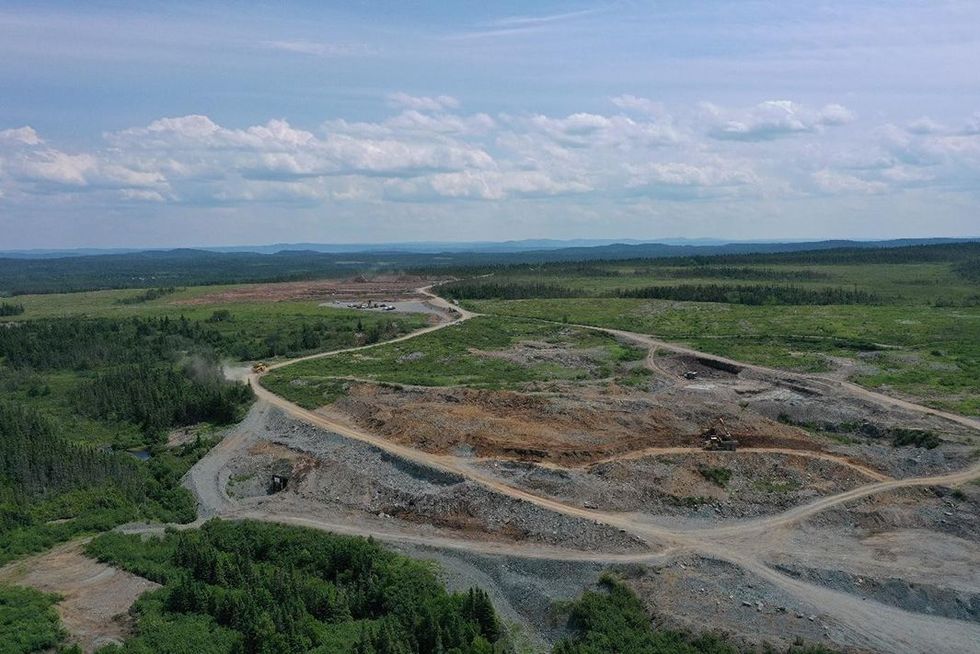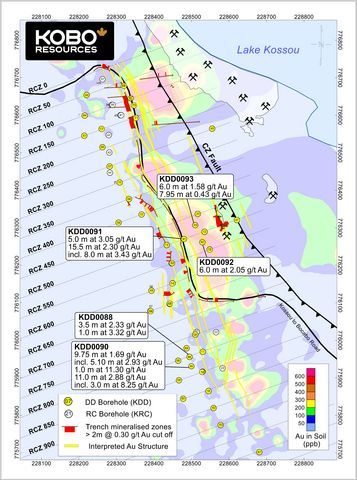Collective Mining Ltd. (TSXV: CNL) ("Collective" or the "Company") is pleased to announce that it has made a significant grassroot discovery at the Pound target ("Pound") within its San Antonio project, Colombia. Pound is one of three targets the Company has generated at the San Antonio project and assay results reported herein are from the recently completed Phase I reconnaissance drill program, which tested two of these targets.
Highlights (Tables and Figures 1 to 5)
- Continuous gold ("Au"), silver ("Ag") and base metal (copper and molybdenum) mineralization has been intersected from surface, over the full core lengths of two reconnaissance diamond drill holes at Pound as follows:
- 710 metres at 0.53 g/t gold equivalent from surface including 133 metres at 0.92 g/t gold equivalent from 470 metre depth (SAC-8); and
- 750 metres at 0.41 g/t gold equivalent from surface including 187 metres at 0.59 g/t gold equivalent from 60 metre depth (SAC-6).
- 710 metres at 0.53 g/t gold equivalent from surface including 133 metres at 0.92 g/t gold equivalent from 470 metre depth (SAC-8); and
- Importantly, both drill holes ended in mineralization with copper and molybdenum grades increasing at depth including:
- 70 metres at 0.12% copper and 89 ppm molybdenum from 681 metre depth (SAC-6); and
- 133 metres at 0.15% copper and 27 ppm molybdenum from 470 metre depth (SAC-8).
- 70 metres at 0.12% copper and 89 ppm molybdenum from 681 metre depth (SAC-6); and
- Pound mineralization is related to hydrothermal breccia and highly altered, quartz diorite intrusive which have been overprinted by late stage, polymetallic veins. Pound is located within a NE-SW trending corridor, as defined by mineralized breccia and altered intrusive, which is open in all directions and has been mapped to date over a strike length of approximately 1.3 kilometres .
- The alteration system associated with Pound (advanced Argillic litho-cap) is related to the upper and peripheral portions of a porphyry system. The Company is currently reviewing its options for follow up exploration which would include initiating a Phase II diamond drill program and a high-resolution and deep penetrating IP survey as has recently and successfully been undertaken at the Guayabales project.
"The wide and continuous zones of mineralization intersected from surface at Pound are exciting and suggest we are either peripheral to or above a very large porphyry system," commented Ari Sussman, Executive Chairman. "It is extremely pleasing that we have made brand new significant discoveries with the initial drill holes into grass root generated targets at both our Guayabales and San Antonio projects. With funding in place through 2022, the Company will become aggressive in the short-term with follow up drilling on our new discoveries and testing newly generated targets across the project portfolio."
Table 1 Initial Diamond Drilling Results at the Pound Target
| Hole ID | From (m) | To (m) | Intercept Interval (m)** | Au (g/t) | Ag (g/t) | Zn (ppm) | Pb (ppm) | Cu % | Mo % | AuEq (g/t)* |
| SAC-6 | 0 | 750 | 750 | 0.32 | 6 | 454 | 303 | 0.02 | 0.001 | 0.41 |
| Incl. | 60 | 247 | 187 | 0.50 | 9 | 274 | 63 | 0.00 | 0.000 | 0.59 |
| And | 681 | 750 | 70 | 0.41 | 2 | 79 | 11 | 0.12 | 0.009 | 0.65 |
| SAC-8 | 0 | 710 | 710 | 0.40 | 6 | 352 | 130 | 0.04 | 0.001 | 0.53 |
| Incl. | 4 | 156 | 152 | 0.50 | 11 | 281 | 65 | 0.01 | 0.000 | 0.62 |
| And | 470 | 603 | 133 | 0.61 | 6 | 504 | 307 | 0.15 | 0.003 | 0.92 |
* AuEq (g/t) = (Au (g/t) x 0.95) + (Ag g/t x 0.013 x 0.90) + (Cu (%) x 1.83 x 0.92) + (Mo (%) x 4.57 x 0.92), utilizing metal prices of Cu - US$4.00/lb, Mo - US$10.00/lb, Ag - $20/oz and Au - US$1,500/oz and recovery rates of 95% for Au, 90% for Ag, 92% for Cu and Mo.
** a 0.1 g/t AuEq cut-off grade was employed with no more than 10% internal dilution. True widths are unknown and grades are uncut.
Geological Details of the San Antonio Project
The San Antonio ("SA") Project is located in the Middle Cauca Gold Belt ("MCB"), 80 km south of Medellin and 50 km north of Manizales, Department of Caldas, Colombia. The MCB has been the most prolific belt for Miocene aged, porphyry and epithermal vein discoveries within Colombia and multi-million ounce discoveries in recent years include Buriticá, La Colosa, Nueves Chaquiro and Marmato.
The SA covers an area of 3,853 hectares and hosts multiple quartz diorite, diorite intrusive and breccia bodies of Miocene age which intrude basement schists and younger volcano-sedimentary packages.
Three specific grassroots exploration targets have been outlined by surface mapping, sampling, soil geochemistry, geophysical modelling, and shallow scout drilling. These are referred to as the Dollar, COP and Pound targets.
The Pound target is located in the northern portion of the project, is defined by multiple hydrothermal breccia bodies hosted within highly altered diorite and quartz diorite intrusive and overprinted by late stage, polymetallic veins. This zone of altered intrusive and breccia bodies trends NE-SW and has been mapped for a strike length of plus 1.3 kilometres. The zone is still open to the NE and SW. Outcrop exposures on the southern border of this target area include epithermal vein systems within a preserved lithocap of advanced argillic alteration which is superimposed on hydrothermal breccia bodies which grades laterally and downwards into intermediate argillic alteration assemblages. These rocks are interpreted to reflect preservation of the shallow levels of the porphyry system. The initial two reconnaissance diamond drill holes, SAC-6 and SAC-8, were drilled to respective downhole depths of 750 metres and 710 metres and intersected various hydrothermal breccia (pyrite matrix), altered quartz diorite intrusive and late-stage polymetallic veins. All the rock units have been hydrothermally altered with an earlier sericitic event overprinted by a strong, advanced argillic phase with various aluminosilicates. At depth, various diorite phases display disseminations and aggregates of chalcopyrite and molybdenite in contact with large blocks of metamorphic schist. The target remains open in all directions and further work is envisaged and will commence with a deep penetrating, high-resolution, induced polarization survey down to minimum depths of 900m below surface followed by a Phase II expanded diamond drilling program. Exploration targets include the mineralized breccia and a porphyry system postulated to occur below the lithocap.
The COP target is located 800 metres south of Pound and is defined by highly anomalous molybdenum (8 ppm to 108 ppm) and gold (up to 2.74 g/t) in soils in association with altered diorite porphyry and quartz veinlets over an area of 650 metres x 350 metres. The surface expression of the COP target is coincident with geophysical anomalies, at 200-300 metres depth which include a positive magnetic anomaly and IP chargeability and resistivity highs. COP has not been tested, other than a single historical borehole drilled just south of the target area, returned an intercept of 99 metres at 0.42 g/t gold and 4.9 g/t silver within unmineralized country rocks partially intruded by mineralized porphyry quartz veins at a depth of 608 meter downhole. The mineralization encountered in the drill-hole is interpreted to be leakage from the COP target directly to the north.
The Dollar target is located 400 metres south of COP. At surface various outcrop of quartz diorite porphyry host stockwork and sheeted quartz-magnetite vein systems associated with disseminated pyrite covering a 500-metre radius. Shallow scout drilling (6 holes) to cover the target area, identified the main mineralized porphyry. Holes SAC-1 to SAC-5 and SAC-9 returned gold intercepts of 0.1 to 0.3 g/t over various angled intercepts of 100 metres to 600 metres length within or across the various outcrops of the mineralized stockwork system. Based on the shallow intercepts a deeper hole was drilled into the mineralized stockwork and returned the intercepts outlined in Table 2 below. Gold, copper and molybdenum grades improve with depth and further deeper drilling is warranted, particularly as the project area is located approximately 300 metres above an accessible valley floor.
Table 2 Initial Deep Diamond Drilling Hole at the Dollar Target
| Hole ID | From (m) | To (m) | Intercept Interval (m)** | Au (g/t) | Ag (g/t) | Zn (ppm) | Pb (ppm) | Cu % | Mo % | AuEq (g/t)* |
| SAC-7 | 0 | 621 | 621 | 0.22 | 3 | 207 | 49 | 0.01 | 0.001 | 0.26 |
| Incl. | 547 | 621 | 74 | 0.49 | 6 | 195 | 19 | 0.05 | 0.001 | 0.62 |
* AuEq (g/t) = (Au (g/t) x 0.95) + (Ag g/t x 0.013 x 0.90) + (Cu (%) x 1.83 x 0.92) + (Mo (%) x 4.57 x 0.92), utilizing metal prices of Cu - US$4.00/lb, Mo - US$10.00/lb, Ag - $20/oz and Au - US$1,500/oz and recovery rates of 95% for Au, 90% for Ag, 92% for Cu and Mo.
** a 0.1 g/t AuEq cut-off grade was employed with no more than 10% internal dilution. True widths are unknown, and grades are uncut.
The San Antonio project benefits from favorable topography with approximately 600 vertical metres of elevation change from the mountain peaks to the various flat lying valleys. Additionally, the topography is not overly steep, lending itself to multiple potential infrastructure development scenarios should an economic deposit be discovered in the future.
Qualified Person (QP) and NI43-101 Disclosure
David J Reading is the designated Qualified Person for this news release within the meaning of National Instrument 43-101 ("NI 43-101") and has reviewed and verified that the technical information contained herein is accurate and approves of the written disclosure of same. Mr. Reading has an MSc in Economic Geology and is a Fellow of the Institute of Materials, Minerals and Mining and of the Society of Economic Geology (SEG).
Technical Information
Rock samples have been prepared and analyzed at SGS laboratory facilities in Medellin, Colombia and Lima, Peru; and Actlabs laboratory facilities in Medellin, Colombia and Toronto, Canada. Certified reference standards are inserted into the sample stream to monitor laboratory performance. Crush rejects and pulps are kept and stored in a secured storage facility for future assay verification. No capping has been applied to sample composites. The Company utilizes a rigorous, industry-standard QA/QC program.
About Collective Mining Ltd.
Collective Mining is an exploration and development company focused on identifying and exploring prospective mineral projects in South America. Founded by the team that developed and sold Continental Gold Inc. to Zijin Mining for approximately $2 billion in enterprise value, the mission of the Company is to repeat its past success in Colombia by making a significant new mineral discovery and advancing the projection to production. Management, insiders and close family and friends own approximately 40% of the outstanding shares of the Company and as a result are fully aligned with shareholders. Collective currently holds an option to earn up to a 100% interest in two projects located in Colombia. As a result of an aggressive exploration program on both the Guayabales and San Antonio projects a total of eight major targets have been defined. The Company is fortuitous to have made significant grass root discoveries on both projects with discovery holes of 104 metres @ 1.2 g/t gold and 12 g/t silver and 710 metres @ 0.53 AuEq at the Guayabales and San Antonio projects, respectfully.
Contact Information
Collective Mining Ltd.
Steve Gold, Vice President, Corporate Development and Investor Relations
Tel. (416) 648-4065
FORWARD-LOOKING STATEMENTS
This news release contains certain forward-looking statements, including, but not limited to, statements about the drill programs, including timing of results, and Collective's future and intentions. Wherever possible, words such as "may", "will", "should", "could", "expect", "plan", "intend", "anticipate", "believe", "estimate", "predict" or "potential" or the negative or other variations of these words, or similar words or phrases, have been used to identify these forward-looking statements. These statements reflect management's current beliefs and are based on information currently available to management as at the date hereof.
Forward-looking statements involve significant risk, uncertainties, and assumptions. Many factors could cause actual results, performance, or achievements to differ materially from the results discussed or implied in the forward-looking statements. These factors should be considered carefully, and readers should not place undue reliance on the forward-looking statements. Although the forward-looking statements contained in this news release are based upon what management believes to be reasonable assumptions, Collective cannot assure readers that actual results will be consistent with these forward-looking statements. These forward-looking statements are made as of the date of this news release, and Collective assumes no obligation to update or revise them to reflect new events or circumstances, except as required by law.
Neither the TSXV nor its Regulation Services Provider (as that term is defined in the policies of the TSXV) accepts responsibility for the adequacy or accuracy of this news release.
Photos accompanying this announcement are available at https://www.globenewswire.com/NewsRoom/AttachmentNg/6bf885fb-0336-4376-9523-a653d2a30dbd
https://www.globenewswire.com/NewsRoom/AttachmentNg/f1fc1cc4-4f61-4fa6-bc50-603b7329d744
https://www.globenewswire.com/NewsRoom/AttachmentNg/29284ce5-7f05-4324-9925-3aa14d80650f
A photo accompanying this announcement is available at https://www.globenewswire.com/NewsRoom/AttachmentNg/9c1bfdb7-349c-4c07-a3af-ae09346fc78a
Hydrothermal breccias, cemented by sericite, carbonates, and sulphides are overprinted by strong advance argillic alteration with pyrite and chalcopyrite and molybdenite mineralization.
A photo accompanying this announcement is available at https://www.globenewswire.com/NewsRoom/AttachmentNg/0d3ee860-4c2b-4c08-88da-f8d4a537b594
Carbonate base metals with galena, sphalerite and pyrite mineralization. Microdiorites and quartzodiorites with secondary biotite alteration with magnetite chacopyrite and pyrite mineralization.
A photo accompanying this announcement is available at https://www.globenewswire.com/NewsRoom/AttachmentNg/8e3b5249-3fc8-4a55-8bb5-16ecc0fabb15
Quartz Diorites porphyry overprinted by strong Sericite alteration, quartz veinlets with magnetite, pyrite, and chalcopyrite.






 Hammerdown project site
Hammerdown project site

